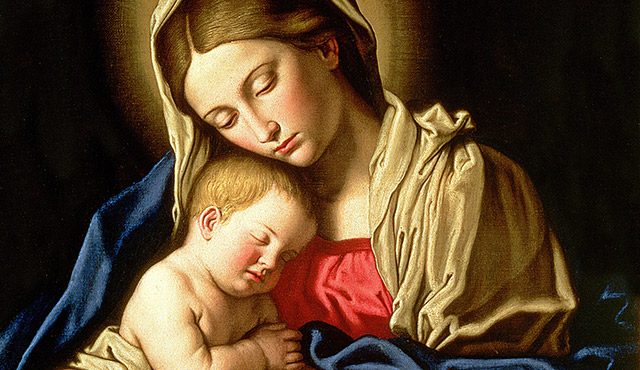During May, the month dedicated to the Blessed Virgin, we see Mary gloriously arrayed, crowned with flowers, gracefully represented in sculpture and painting and stained glass, and we venerate her as queen of Heaven, the saint above all other saints—the mother of God. Seeing her surrounded by all the pageantry and prayers, it can be difficult to think of her as just plain Mom.
But that was what she once was. Though little is found in Scripture about Jesus’ early years, we know that he grew up in Nazareth as the son of Joseph and Mary and eventually embarked on his public ministry as an adult. What happened in the intervening years, and what Mary’s role was during that time, can be surmised from what historians, anthropologists, archaeologists, biblical scholars and others have studied and set down.
Drawing on both Scripture and tradition, Father Victor Hoagland, C.P., writes on the Passionist website “Compassion” that Mary’s birthplace is in dispute, some claiming it was Jerusalem, others Nazareth and still others Sepphoris, a town a few miles from Nazareth. In any case, “Mary’s life most likely unfolded in the staunch Jewish settlement of Nazareth in the hills of Galilee,” writes Father Victor. She was surrounded by “a strong, robust people” in a dry and healthy climate where the residents were hard-working, close-knit and deeply religious.
Small and conservative, Nazareth at the time of Mary had a population of no more than 400, according to the website womeninthebible.net, and Mary likely knew everyone in town. She was likely physically robust, strong-minded and practical and spoke Aramaic. She probably did not read—this was an activity usually reserved for men so they could read the Torah—but she likely knew many Scripture stories by heart, having heard them told or seen them acted out for entertainment.
Mary probably lived in a small family house of stone and mud-brick and spent her days as the other women in the area did: “grinding wheat and barley into flour, [and] preparing dishes of beans, vegetables, eggs, fruits, nuts and occasional chunks of mutton. Wool had to be made into clothing. Bread had to be baked. A few chickens and a donkey had to be fed. And in the village, small as it was, there were always little children to care for.”
Mary would have paid daily visits to the local well, and not only to fetch water for cooking and washing. “The well,” writes Father Victor, “also was a favorite spot where women talked and traded bits of everyday news.”
She also helped sow and gather the crops and other local foods, such as wheat, olives, figs and other fruits such as grapes and pomegranates. She baked bread.
Because the residents of Nazareth were a people who had been subjugated under a succession of foreign rulers and invasions, they developed a strong religious faith and clung to the hope of deliverance by a messiah. Their lack of power was underscored in 6 A.D., when Jesus was a child, when Roman legions captured the city of Sepphoris, sold all its inhabitants into slavery and burned the city to the ground.
“Mary’s faith was strong,” writes Father Victor. “Yet, in fervently religious Nazareth with its high moral standards, she hardly stood out at all, even in the eyes of those who knew her best. Besides, as a woman living in a society where men counted most, she would be little noticed except as a mother and a wife.”
In fact, says Sister Eymard Flood, O.S.C., Vicar for Consecrated Life for the Diocese of Orange, Mary probably received no formal education and was “limited by Jewish laws and customs.” She might have been required to wear a veil when going out in public and was likely forbidden to talk to strangers. “She would have little or no authority,” says Sister Eymard. “At age 12 to 12½ she could be sold as a slave to a Jew by her father.” Her marriage to Joseph, hewing to custom, would have been arranged.
Like most of their neighbors, Joseph and Mary would have been homebodies, seldom venturing beyond their village and the neighboring fields. “Their home,” says Father Victor, “was one simple room, used for work by day and as a bedroom by night. In the limestone floor were small openings into grain silos, carved for storage out the rock below floor level. On the wall [was] a niche for an oil lamp, the only light in the windowless room. On summer days, a shelter of branches shaded the flat roof above.”
After the death of Joseph, Mary raised Jesus alone. “It would be natural that Mary’s imprint appear in Jesus’ later teachings,” writes Father Victor. “The way he valued childhood and family life surely came from rich memories of home life at Nazareth and its simplicity, trust and love. His later parables and teachings show his esteem for the faith and patience of women and condemn the injustices done to them in the male-dominated society of his time. His advocacy and appreciation for women surely followed his love and respect for the woman who was his mother.”
His mother has been depicted as submissive and quiet, but “as a Jewish peasant woman, it is unlikely that she was either of these things,” according to womeninthebible.net. “The story of the wedding at Cana gives us an example of Mary’s assertiveness as she insists that Jesus help in a difficult situation.”
Mary’s life was not easy by any stretch. But according to Scripture and tradition, she lived it with uncommon devotion, grace and selflessness. For all the delicacy of the artistic depictions of her in future centuries, she was, by most informed accounts, sturdy and capable, able to celebrate the joys and navigate the bumps of daily family life—a real-world mom who happened to have an otherworldly son.

